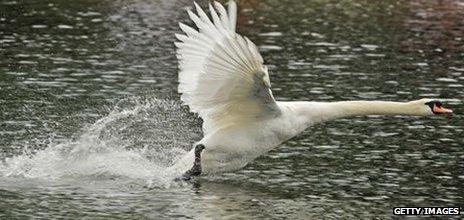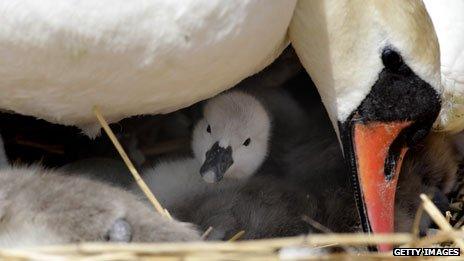Who, What, Why: How dangerous are swans?
- Published

A man has drowned after being attacked by a swan, which knocked him out of his kayak and stopped him swimming to shore. So how dangerous are these graceful white birds?
Anthony Hensley, 37, worked for a company that provided swans to keep geese away from property.
On Saturday morning, the married father of two set out in a kayak across a pond at a residential complex in Des Plaines, just outside Chicago, where he was tending the birds.
One of the swans charged his boat, capsizing it, says Cook County Sheriff Tom Dart, whose deputies investigated the death.
Mr Hensley tried to swim to shore but eyewitnesses told the sheriff's investigators the swan appeared to have actively blocked him.
"I find myself still scratching my head," says Sheriff Dart. "This truly is one of the ones that keeps you from saying 'I've seen everything now.'"
According to ornithologists, the swan's aggressive reaction is typical for the species, the mute swan, when defending a nest.
"It's presumably a male swan and it's presumably paired, and it's set up home for the spring," says Chris Perrins, Her Majesty's Swan Warden and a retired Oxford ornithologist.
"It's going to defend that territory."
The males are fierce in defence of their nests, especially during the spring nesting season - April to June.
The birds are one of the largest waterfowl in North America and Europe, weighing up to 13kg (28lbs) and with a wing span of up to 2.4m (7.9ft). They are among the heaviest flying birds in the UK.
In April 2010, a swan on the River Cam in England made the news after repeatedly attacking rowers. It was nicknamed Mr Asbo, named after the Anti-Social Behaviour Orders issued by UK courts at the time. Two years later, there are still calls for it to be removed from the river, as the seasonal attacks go on.
But such incidents are very rare, says John Huston of the Abbotsbury Swannery in Dorset, where there are 1,000 swans but no recorded attacks on humans in the colony's 600-year history.
"If you approach a swan nest on the river, they might get aggressive and hiss and flap their wings, but the danger is over-rated and it's a myth that they will break your leg or arm with their wings.
"They are not that strong and it's mostly show and bluster."

Perrins says he has spent many years handling swans and never been injured, just received the odd bruise.
"They do fairly vigorously defend their little patch this time of year. Once the eggs are hatched he'll stay with the family and defend it.
"They have a reputation for being a bit aggressive, but it's only that it's a matter of size, I guess. Presumably a duck wouldn't attack you because you look a bit big."
However, a large swan can give a thump, he says, and the best advice is to stay away from the nest, which is often a place along the bank or shore where the reeds are flattened and the female is sitting.
Mute swans often defend in pairs, says Julia Newth, research officer at the Wildlife and Wetlands Trust.
"Habitats with abundant food and with suitable nesting sites may be highly fought over.
"Those intruding on their territory, including large wildfowl, land mammals and people, may be warded off with an aggressively fast swimming approach, often accompanied with hissing and busking, which is a threat display where the swans neck is curved back and its wings are half raised.
"Mute swans tend to use the power of their wings to attack rather than their beaks."
John Faaborg, a biologist at the University of Missouri and president of the American Ornithologists' Union, has known people who were hurt by geese attacks.
"And I am sure that swans can do major damage given that they are so big."
In this case in Chicago, he says, it's understandable that someone in a river with their clothes and shoes on was unable to overpower a swan and swim to shore.
Reporting by Daniel Nasaw and Tom Geoghegan